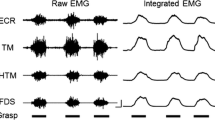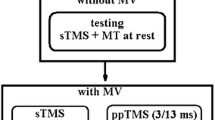Summary
The cerebral evoked potential produced by rapid extension of the wrist was recorded from scalp electrodes in normal subjects while they exerted a small background flexor torque (0.24 Nm) against an electric motor. The initial part of the response consisted of a negative deflection (N1) with an average latency of 24.7 ms. This was followed by a biphasic P1/P2 (32 ms) response and a large later negative wave (N2) (76 ms). Passive wrist extension also evoked reflex EMG responses in the forearm flexor muscles which could be resolved into a short latency (25 ms) and long-latency (52 ms) component. The cerebral responses persisted almost unchanged during complete ischaemic anaesthesia of the hand produced by a pressure cuff around the wrist, and were reduced if the stretch was given during voluntary wrist flexion. The primary component (N1-P1/ P2) of the cerebral response probably represents the arrival at the cortex of the muscle afferent volley. However, the significance of the secondary component (P1/P2-N2) is unknown. Under certain conditions, its size was related to the size of the long latency stretch reflex evoked by stretch of the flexor muscles. Thus, increasing the velocity of stretch or decreasing the repetition rate (from 1.0 to 0.15 Hz) at which stretches were applied, increased the size of both the muscle reflex and the cerebral response. The secondary component also could be changed by voluntary reaction to wrist stretch. Changes in the size of the secondary component of the evoked response may represent the earliest cortical sign of interaction between sensory input and motor output.
Similar content being viewed by others
References
Abbruzzese G, Cocito L, Ratto S, Abbruzzese M, Leandri M, Favale E (1981a) A reassessment of sensory evoked potential parameters in multiple sclerosis: a discriminant analysis approach. J Neurol Neurosurg Psychiat 44: 133–139
Abbruzzese G, Ratto S, Favale E, Abbruzzese M (1981b) Proprioceptive modulation of somatosensory evoked potentials during active or passive finger movements in man. J Neurol Neurosurg Psychiat 44: 942–949
Berardelli A, Hallett M, Kaufman CK, Fine E, Berenberg W, Simon SR (1982) Stretch reflexes of triceps surae in normal man. J Neurol Neurosurg Psychiat 45: 513–515
Burke D, Hagbarth K-E, Lofstedt L (1978) Muscle spindle activity in man during shortening and lengthening reactions. J Physiol (Lond) 277: 131–142
Burke D, Skuse N, Lethlean AK (1981) Cutaneous and muscle afferent components of the cerebral potential evoked by electrical stimulation of human peripheral nerves. Electroenceph Clin Neurophysiol 51: 579–588
Burke D, Gandevia SC, McKeon B, Skuse NF (1982) Interactions between cutaneous and muscle afferent projections to cerebral cortex in man. Electroenceph Clin Neurophysiol 53: 349–360
Cheney PD, Fetz EE (1984) Corticomotoneural cells contribute to long-latency stretch reflexes in rhesus monkey. J Physiol (Lond) 349: 249–272
Conrad B, Dressler D, Benecke R (1984) Changes of somatosensory evoked potentials in man as correlates of transcortical reflex mediation? Neurosci Lett 46: 37–107
Day BL, Rothwell JC, Marsden CD (1983) Interaction between the long latency stretch reflex and voluntary electromyographic activity prior to a voluntary motor reaction. Brain Res 270: 55–62
Desmedt JE, Tran Huy N, Bourguet M (1983) The cognitive P40, N60 and P100 components of somatosensory evoked potentials and the earliest electrical signs of sensory processing in man. Electroenceph Clin Neurophysiol 56: 272–282
Evarts EV, Granit R (1976) Relation of reflexes and intended movements. In: Homma S (ed) Understanding the stretch reflex. Elsevier/North Holland Biomedical Press, Amsterdam, pp 1–14
Gandevia S, Burke D, McKeon B (1982) The relationship between the size of a muscle afferent volley and the cerebral potential it produces. J Neurol Neurosurg Psychiat 45: 705–710
Gandevia S, McKeon B, Burke D (1983) The effect of warning and prior instruction on short-latency cerebral potentials produced by muscle afferents in man. J Neurol Neurosurg Psychiat 46: 430–436
Gandevia SC, Burke D, McKeon B (1984) The projection of muscle afferents from the hand to cerebral cortex in man. Brain 107: 1–13
Ghez C, Shinoda Y (1978) Spinal mechanisms of the functional stretch reflex. Exp Brain Res 32: 55–68
Hagbarth K-E, Hagglund JV, Wallin EU, Young RR (1981) Grouped spindle and electromyographic responses to abrupt wrist extension movements in man. J Physiol (Lond) 312: 81–96
Lee RG, Tatton WG (1975) Motor responses to sudden limb displacements in primates with specific CNS lesions and in human patients with motor system disorders. Can J Neurol Sci 2: 285–293
Lee RG, Tatton WG (1982) Long latency reflexes to imposed displacements of the human wrist: dependance on duration of movement. Exp Brain Res 45: 207–216
Marsden CD, Merton PA, Morton HB (1973) Is the human stretch reflex cortical rather than spinal. Lancet i: 759–761
Marsden CD, Rothwell JC, Day BL (1983) Long-latency automatic responses to muscle stretch in man: origin and function. In: Desmedt JE (ed) Motor control mechanisms in health and disease. Raven Press, New York, pp 509–539
Matthews PBC (1984) Evidence from the use of vibration that the human long-latency stretch reflex depends upon spindle secondary afferents. J Physiol (Lond) 348: 383–415
Merton PA, Morton HB (1980) Stimulation of the cerebral cortex in the intact human subject. Nature 285: No. 5767, 227
Oscarsson O, Rosen I (1963) Projection to cerebral cortex of large muscle spindle afferents in forelimb nerves of the cat. J Physiol (Lond) 169: 924–945
Phillips CG, Powell TPS, Wiesendanger M (1971) Projection from low-threshold muscle afferents of hand and forearm to area 3a of baboon's cortex. J Physiol (Lond) 217: 419–446
Rothwell JC, Traub MM, Marsden CD (1980) Influence of voluntary intent on the human long latency stretch reflex. Nature 286: 496–498
Rushton DN, Rothwell JC, Craggs MD (1981) Gating of somatosensory evoked potentials during different kinds of movement in man. Brain 104: 465–491
Ruegg DF, Chofflon M (1983) Peripheral and transcortical loops activated by electrical stimulation of the tibial nerve in the monkey. Exp Brain Res 50: 793–798
Starr A, McKeon B, Skuse N, Burke D (1981) Cerebral potentials evoked by muscle stretch in man. Brain 104: 149–166
Wiederholt WC, Meyer-Harding E, Budnick B, McKeown KL (1982) Stimulating and recording methods used in obtaining short-latency somatosensory evoked potentials (SEPs) in patients with central and peripheral neurologic disorders. Ann New York Acad Sci 388: 349–358
Author information
Authors and Affiliations
Rights and permissions
About this article
Cite this article
Abbruzzese, G., Berardelli, A., Rothwell, J.C. et al. Cerebral potentials and electromyographic responses evoked by stretch of wrist muscles in man. Exp Brain Res 58, 544–551 (1985). https://doi.org/10.1007/BF00235870
Received:
Accepted:
Issue Date:
DOI: https://doi.org/10.1007/BF00235870




